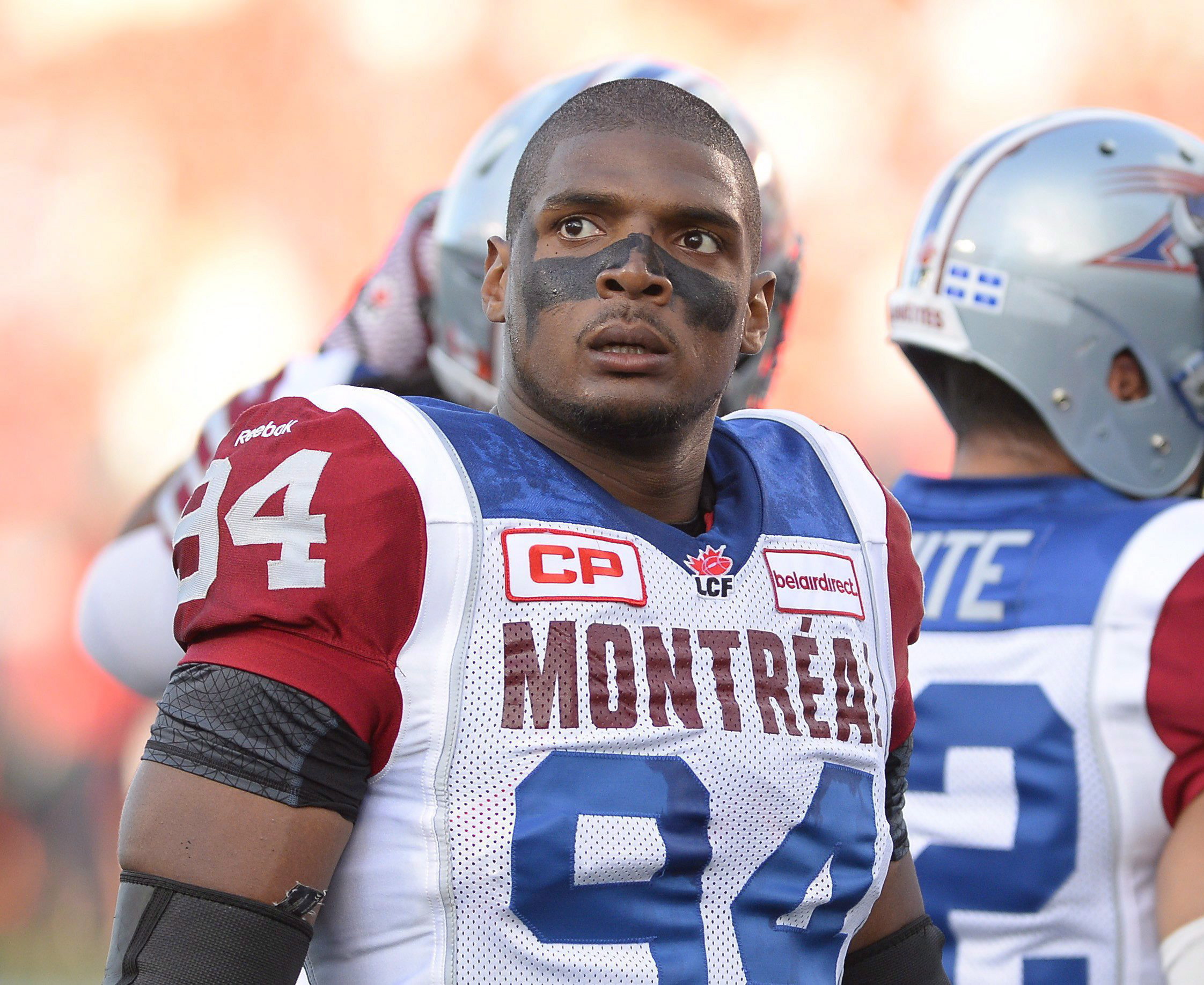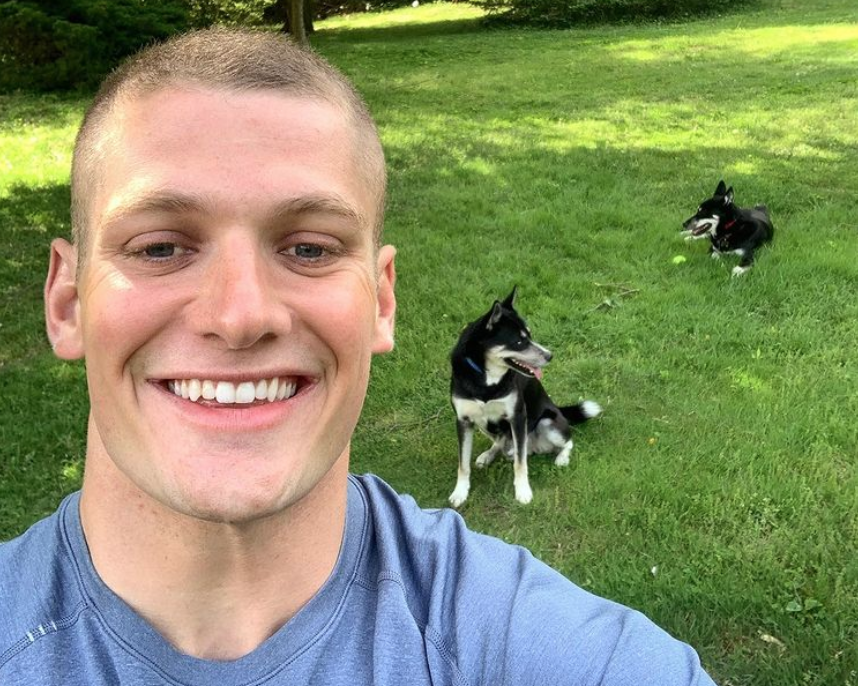It’s a milestone that feels both remarkable and decades behind the curve: the NFL has its first openly gay active player.
On Monday night, Las Vegas Raiders defensive end Carl Nassib came out as gay in an Instagram post.
“I just wanted to take a quick moment to say that I’m gay,” the 28-year-old said in a video shared to Instagram. “I’ve been meaning to do this for a while now, but finally feel comfortable getting it off my chest. I really have the best life, the best family, friends and job a guy can ask for.”
Nassib was a third-round pick for the Cleveland Browns in 2016, and joined the Raiders last season after a stint with the Tampa Bay Buccaneers.
He said he hopes coming out messages like his won’t always be necessary, but acknowledged the importance of representation and being open. He also mentioned the high suicide rates of LGBTQ2S+ youth in his message, and said he was donating $100,000 to the Trevor Project, which provides crisis and mental health suppport to queer and trans youth. The organization reported a huge surge in donations following Nassib’s announcement.
With his declaration, Nassib becomes the first openly gay active player in NFL’s history. Nassib is not the first NFL player to come out as gay, though—and with more than 1,600 active players in the league and the rough estimate that 5.6 per cent of American adults identify as LGBTQ2S+, he’s likely not even the only gay active player taking to the field in 2021.
But he is the first to disclose, the first to come out and to speak openly about his sexuality while playing in the controversial and often problematic sports league. For a league that’s historically struggled with homophobia, it’s a big deal. For queer fans like me who’ve watched the NFL our entire lives and always wondered when we’d see ourselves reflected in the game, it’s monumental. And for young queer players wondering if there’s a place for them in the upper echelon of professional football, it’s massive.
“For someone like me, who has been so lucky and cherishes every day, it brings me incredible sadness to think that our LGBTQ youth are at such an elevated risk for suicide,” Nassib wrote.
“I feel an immense responsibility to help in any way I can.”
From Dave Kopay to Michael Sam to Carl Nassib
In his coming out announcement, Nassib referenced those who paved the way for him. Six former NFL players have come out publicly after retiring from the league, the first of whom being Dave Kopay in 1975. His memoir, The David Kopay Story, came out in 1977.
Kopay spoke openly about the existence of other gay players in the league. In 1986, he revealed he had a brief affair with Jerry Smith, a player for Washington’s football team from 1965 to 1977 who died of AIDS without ever having publicly come out.
Since Kopay, former NFL players Roy Simmons, Esera Tuaolo, Wade Davis, Kwame Harris and Ryan O’Callaghan have come out as gay after retiring from the game.
In 2014, Michael Sam was drafted in the seventh round by the St. Louis Rams. Months earlier, in an interview with the New York Times and ESPN, he publicly declared that he was gay after coming out to his college team the previous year.
Hype from fans around Sam’s participation in the league was huge—during the period spanning April 1 to July 17, 2014, his jersey ranked sixth in sales among all NFL players.

Credit: Justin Tang/CP Images
But after being released from the Rams, Sam never started a regular season game in the NFL. Following a brief stint on the Dallas Cowboys practice squad, he played briefly in the Canadian Football League, becoming he first openly gay player to do so. He retired in August 2015, citing mental health reasons. Sam now speaks to college students across America about his experiences.
“I sacrificed my career for me to live my life,” he said in a 2019 interview. “That being said, it also helped a lot of people in the process. I have to believe that it helped people. Football gave me so much. It was my dream. If I could save some lives by sacrificing my career, that’s what I have, and I am grateful for it.”
How the world reacted to Nassib
Here in 2021, Nassib’s announcement and pledge to advocate for LGBTQ2S+ rights was met with widespread acclaim and support. Both the official Las Vegas Raiders team and official NFL social media accounts reposted his statement with congratulations.
“I learned a long time ago what makes a man different is what makes him great,” Raiders head coach Jon Gruden said following the announcement.
“It’s 2021,” Raiders owner Mark Davis told ESPN shortly afterwards. “All the more power to Carl. It doesn’t change my opinion of him as a person or as a Raider.”
In a statement, NFL commissioner Roger Goodell praised Nassib’s “courage.” The NFL also announced Tuesday it would be matching Nassib’s $100,000 donation to the Trevor Project.
“The NFL family is proud of Carl for courageously sharing his truth,” Goodell wrote. “Representation matters. We share his hope that someday soon statements like his will no longer be newsworthy as we march toward full equality for the LGBTQ+ community.”
Support also rolled in from other queer trailblazers, like tennis star Billie Jean King, who came out publically in 1981.
But some reactions—or the lack thereof—to Nassib’s announcement highlight why it took so long for an active NFL player to come out.
“When it comes to current stars in the NFL, there weren’t many who publicly supported Nassib yesterday,” writer Jimmy Traina pointed out in a Sports Illustrated column on Tuesday.
While stars like J.J. Watt and Nassib’s former college teammate Saquon Barkley applauded Nassib’s announcement, the league’s brightest stars, like notable MAGA-hat owner Tom Brady and even Nassib’s own quarterback, Derek Carr, were markedly silent.
Media handling of Nassib’s announcement has also been mixed, to say the least. The New York Times initially ran a story on Nassib with the headline “Carl Nassib Was an N.F.L. Everyman. Then He Came Out as Gay” before swfitly rolling it back after online backlash. On ESPN, an on-screen textbox identified Nassib as the “first actively gay NFL player,” instead of the first openly gay active player.
And on Tuesday morning, The View co-host Joy Behar apologized after making a homophobic joke on the live program.
Nassib’s coming out is a huge deal. It took a long time to get here, but responses like these show there’s still work to be done. In a moment where conversations around trans peoples’ participation in sports are so fraught, with some politicians even trying to legislate young trans atheletes out of existence, a cisgender gay NFL player feels like a bridge we should’ve crossed long ago. But the road to get to this point was hard, and the NFL is still rife with homophobia. Nassib said he’s struggled with the decision to speak publicly for 15 years—that’s more than half of his life.
Homophobia is just one of many ills that the NFL struggles with. The league’s handling of Colin Kaepernick’s kneeling during the national anthem before games shows it has a long way to go in its treatment of Black players. The way domestic violence allegations are handled is unacceptable. And professional football leaves hundreds of men with lasting traumatic brain injuries and little support from the institution.
That’s besides other issues of representation in a league that only recently celebrated the involvement of female coaches, referees and front office executives.
Maybe one day Nassib’s wish will come true and announcements like his won’t be heralded as historic. Maybe one day we’ll see special rainbow uniforms like we do for military appreciation or breast cancer awareness. Maybe one day we’ll have a female NFL player or a trans NFL player.
But until then, Carl Nassib’s coming out has added points on the board towards progress in the NFL. And for that, we should cheer.


 Why you can trust Xtra
Why you can trust Xtra


